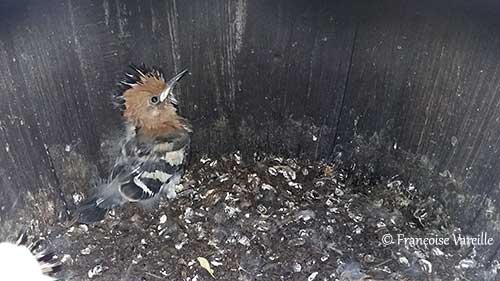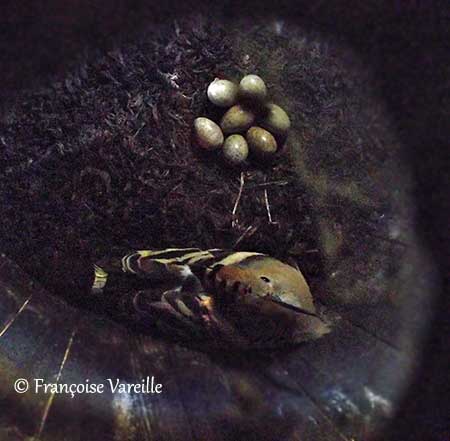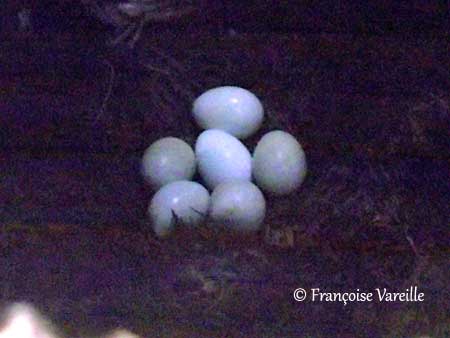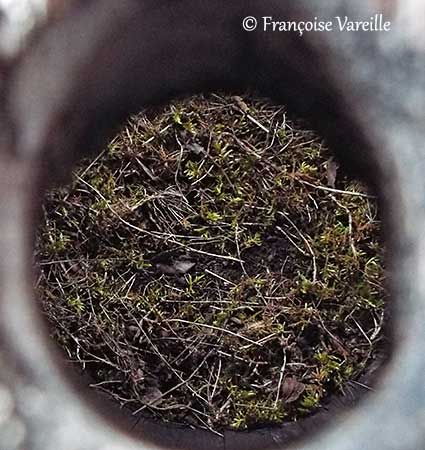The young will stay with their parents for another week. They will be fed, but they will also learn to hunt in order to become independent.
We wish them good luck!
The Hoopoe is declining due to habitat destruction and hunting in parts of the wide distribution. However, it is not currently considered endangered and the species is protected in most of the distribution.
You can find here the reproduction 2017, with a big surprise!
Many thanks to Françoise Vareille for this wonderful observation.
The flash was not used for these photos. The light passing between the boards of the cask was sufficient for the shooting.
The text was written by Nicole Bouglouan, according to the notes and information provided by Françoise Vareille.
All pictures on this page are owned by Françoise Vareille.
These images and the text are subject to copyright and cannot be used without express authorization from the owners. Legal issues

HOOPOE'S REPRODUCTION 2016
(Upupa epops)
Observation report
This observation report was made possible thanks to Françoise Vareille who was able to follow in her garden, and for the third consecutive year, the reproduction of a pair of Hoopoes (see the card of this species).
The nest is established in an old cask in Françoise’s garden, in Provence (France). A first clutch hatched in April, and all the chicks survived and are now in the wild. The subject of this observation is the third brood of the season, a replacement clutch because the second brood has been lost, probably caused by a predator. Three eggs were outside the cask while the others were inside. The adults cleaned the nest prior to the third laying.
A hole at the top of the cask allows taking pictures without opening and with a minimum of disturbance for the birds already accustomed to the comings and goings around the cask for garden maintenance.
Several copulations occurred, and one was observed on June 8 (but there have been others before).
The first egg was laid on June 11 and the seventh on June 17. The eggs are white, slightly bluish at first, but they become stained as the incubation is in progress, performed by the female, fed by the male during this period.
On the picture below, the clutch is not complete. The recent eggs are still whitish, unlike those on the following picture which are stained after one day more in the nest.

The incubation period generally varies from 15 to 18 days, and on June 27, the first chick hatched. It is entirely covered with fine, white down. It will keep it during the first 4-5 days.
The chicks are brooded by the female for the first few days, and the male brings food to the nest. Then both adults hunt and feed the young.
July 11, 7 eggs, it now remains four live chicks, two dead and one unhatched egg. The nest is very dirty, not cleaned by the parents. The bodies of two dead chicks are still in the nest.
This behavior is part of the protection of nest and young. But predators are also sent away by the stench produced by the uropygial gland of both female and chicks. This substance also seems to remove various parasites.
On July 13, this chick is 17 days old.
Around July 20, a chick’s head is visible at the entrance of the cask. An adult feeds it. Already want to go out?
Both parents continue to bring food to the nest, and then, they remain in nearby trees. They try to attract the juveniles out of the nest. They will leave the nest very soon.
July 21, in the late afternoon, only two nestlings still are in the nest.
On July 22, in the early morning, there is only one chick in the nest. It is similar to adults except the white gap.
And in the late morning, everybody go! The remains of a dead chick are visible, especially the bill.

